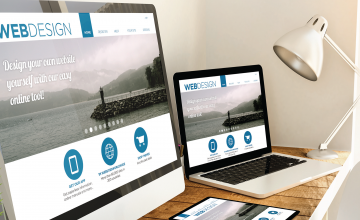מאמרים נוספים

כיצד תהפוך את האתר שלך לרלוונטי באופן תמידי?
כל אתר צריך בלוג, בשביל קידום אתרים במנועי החיפוש ולהפוך אותו לרלוונטי באופן תמידי ושוטף בגלל שכל תחום

כיצד לאפשר למשתמשים ליצור פרופיל ציבורי
חוץ מפייסביוק,טוויטר ואינסטרגם גם לגוגל יש רשת חברתית שנקראת גוגל + או גוגל פלוס (באנגלית: +Google או: Google Plus) היא רשת חברתית באינטרנט
קטגוריות
מאמרי ארכיב

Understanding the Goal of a Results-Driven Website
As the digital landscape evolves, businesses must adapt to engage their target audiences effectively. A results-driven website is not just about aesthetics but is fundamentally about achieving specific business goals. In Jerusalem and across Israel, small and medium-sized enterprises, online retailers, institutions, entrepreneurs, and service professionals can greatly benefit from such a website. Here we delve into what makes a website results-oriented.
Defining Business Objectives and KPIs
Every successful website begins with clear business objectives. Ask questions like, "What do we want to achieve with this website?" Is it to increase sales, drive brand awareness, or generate leads? Objectives set the foundation for future success. Once objectives are defined, translating them into key performance indicators (KPIs) like conversion rates or time spent on site helps track progress. For example, a retailer might target a 20% increase in online sales, while a non-profit organization may aim to boost online donations by 15%.
Identifying Target Audiences and User Personas
Understanding the audience is crucial. Identifying who will visit your website allows you to create user personas that represent the diverse segments of your audience. A small business owner might target local customers, while a manufacturer might reach out to international distributors. By tailoring content and design to these personas, businesses can improve engagement and conversions.
Conducting Competitive Benchmarking and Market Research
To stand out, a website must outperform competitors. This requires thorough competitive benchmarking and market research. Analyze competitors’ features, content, and user experiences to find areas of improvement. For a start-up, this might mean offering more personalized user experiences or faster customer support than competitors. Such tactical insights ensure the website meets market expectations and appeals to the desired audience.
Planning and Structure: Building a Solid Foundation
A well-planned website ensures seamless user experience and optimal performance. It's akin to constructing a building with a robust blueprint — every detail matters.
Crafting an Effective Site Map
A site map functions as a blueprint for the website. It lays out all the pages, helping to organize the site’s structure. For a business with multiple product lines, a hierarchical site map is essential to guide users efficiently to the information they seek.
Choosing the Right Platform and Tech Stack
Selecting the right platform and technology is vital for functionality and scalability. E-commerce businesses could benefit from platforms like Shopify or WooCommerce, which offer robust tools for managing online sales. Consider technological compatibility with existing systems and future growth needs to ensure the site's longevity.
Designing Intuitive Navigation Flows
Navigation is the roadmap for your audience. It should be intuitive and straightforward. For example, a navigation bar with clearly labeled categories like "Products," "Services," "About Us," and "Contact" ensures that visitors can easily find what they need, reducing bounce rates and enhancing user satisfaction.
Design and User Experience: Converting Visitors into Customers
The impact of first impressions cannot be underestimated, especially online. An effective website merges design with user experience to convert visitors into loyal customers.
Implementing Responsive and Mobile-First Design
With more people accessing the web through smartphones, responsive and mobile-first design is non-negotiable. A mobile-first approach ensures that the site looks and functions well on smaller screens, essential for reaching on-the-go consumers. This can lead to increased engagement and lower bounce rates.
Establishing Clear Calls-to-Action and Visual Hierarchy
Calls-to-action (CTAs) like "Buy Now," "Sign Up," or "Contact Us" should be prominent and compelling. The visual hierarchy helps users focus on these CTAs by guiding their eyes naturally through the content. For instance, using contrasting colors for CTAs against a minimalist background can draw attention more effectively.
Maintaining Branding Consistency and Trust Signals
Consistency in branding—from color schemes to typography—builds trust and recognition. Incorporating elements like customer testimonials, security badges, and clear privacy policies also fosters trust. This is crucial for start-ups and small businesses looking to establish credibility in their industries.
Development and Performance: Ensuring Reliability and Speed
A website’s development and performance are directly linked to its success. Reliability and speed are crucial factors that affect user satisfaction and SEO rankings.
Optimizing Page Load Times and Code Efficiency
Fast-loading pages make a significant difference in user retention. Compressing images, minimizing code, and leveraging browser caching are effective strategies to improve load times. Research shows that even a one-second delay in load time can lead to a 7% reduction in conversions.
Implementing Security Best Practices
Security is a top priority, especially for e-commerce platforms handling sensitive customer information. Implementing SSL certificates, firewalls, and regular security audits protects against breaches, thus safeguarding customer trust and data.
Leveraging Scalable Hosting and Infrastructure
Choosing scalable hosting ensures your website can handle growth and increased traffic. For businesses anticipating significant expansion, platforms like AWS or Google Cloud provide the infrastructure needed to support scaling without sacrificing performance.
SEO and Content Strategy: Driving Organic Traffic
Search engine optimization (SEO) drives organic traffic, crucial for visibility and engagement. A strategic content approach complements SEO efforts.
Conducting Keyword Research and On-Page Optimization
Effective SEO starts with thorough keyword research to understand what potential customers are searching for. Incorporating relevant keywords into content, meta titles, and descriptions enhances visibility. For instance, an online retailer might use keywords like "affordable Israeli fashion" to attract targeted visitors.
Creating High-Quality, Relevant Content
Content forms the core of any optimization strategy. Blogs, videos, and infographics that provide value can engage users and encourage sharing. Consistently publishing content that answers common questions or provides insider tips keeps audiences returning and boosts SEO.
Managing Technical SEO and Metadata
Beyond content, technical SEO aspects like optimizing website architecture, improving site speed, and ensuring mobile-friendliness are vital. Properly managing metadata—titles, descriptions, tags—ensures search engines comprehend the content, improving indexing and ranking.
Analytics, Automation, and Continuous Improvement
As the saying goes, if you can’t measure it, you can’t improve it. Continuous monitoring and optimization are critical for digital success.
Setting Up Tracking and Conversion Goals
Tools like Google Analytics allow businesses to track user behavior, assess the effectiveness of calls-to-action, and identify high-converting pages. Setting clear conversion goals, such as completed purchases or form submissions, helps in measuring the website’s success.
Leveraging Marketing Automation Tools
Automating marketing tasks like sending personalized emails or reminders through tools like Mailchimp or HubSpot can save time and enhance user engagement. Automation ensures timely, relevant communication that nurtures leads and retains customers.
Running A/B Tests and Iterative Optimization
A/B testing different versions of web pages or elements helps identify what resonates most with users. Continuous tweaks based on these tests lead to iterative improvements, enhancing the site’s overall performance and user experience.
By understanding and implementing these comprehensive strategies, businesses in Jerusalem and beyond can create websites that not only achieve their immediate goals but also set the stage for long-term success. At WebConcepts, under the guidance of Yitzhak Nechmad, we are committed to helping you navigate the dynamic world of digital presence. Whether you’re looking to create an online store, promote your brand, or drive strategic growth, we provide the expertise and tools to help you succeed.
For more information on how we can assist your business, visit our website or contact us to start building your results-driven website today. WebConcepts is here to help you succeed!
מאמרים חדשים
הנצפים ביותר
- 4694 hits אז למה בעצם כל כך חשוב אתר אינטרנט לעסק שלך by יצחק נחמד - וובמסטר
- 3118 hits מה זה שפת HTML5? by יצחק נחמד - וובמסטר
- 2478 hits איך לבנות אתר טוב ונכון בצורה קלה ומהירה by יצחק נחמד - וובמסטר
- 488 hits בניית קישורים כאסטרטגיה עסקית לעסקים קטנים ובינוניים: מדריך ל-SEO יעיל ושיפור דירוגים by Alok Ranjan
- 462 hits בניית קישורים: איך למקסם את הנראות של האתר שלך במנועי החיפוש ואסטרטגיות אפקטיביות לשיפור מיקום by Alok Ranjan
פורסם לאחרונה
- Oct 17, 2025 Mastering עיצוב אתרים יצירתי עם אסטרטגיה חכמה by יצחק נחמד - וובמסטר
- Sep 25, 2025 5 יתרונות מרכזיים לבניית אתר בוובקונספטס by יצחק נחמד - וובמסטר
- Oct 8, 2024 בניית קישורים כאסטרטגיה עסקית לעסקים קטנים ובינוניים: מדריך ל-SEO יעיל ושיפור דירוגים by Alok Ranjan
- Oct 8, 2024 בניית קישורים: איך למקסם את הנראות של האתר שלך במנועי החיפוש ואסטרטגיות אפקטיביות לשיפור מיקום by Alok Ranjan
- Apr 29, 2020 מה זה שפת HTML5? by יצחק נחמד - וובמסטר











